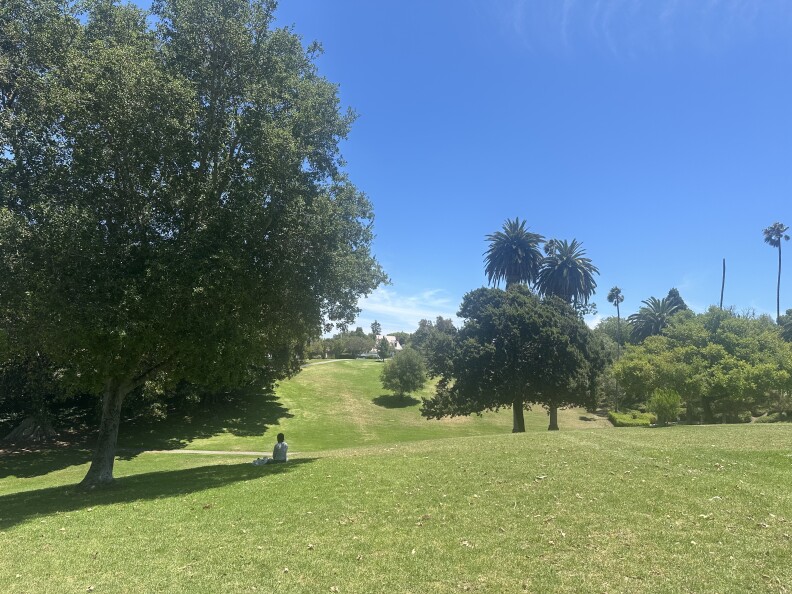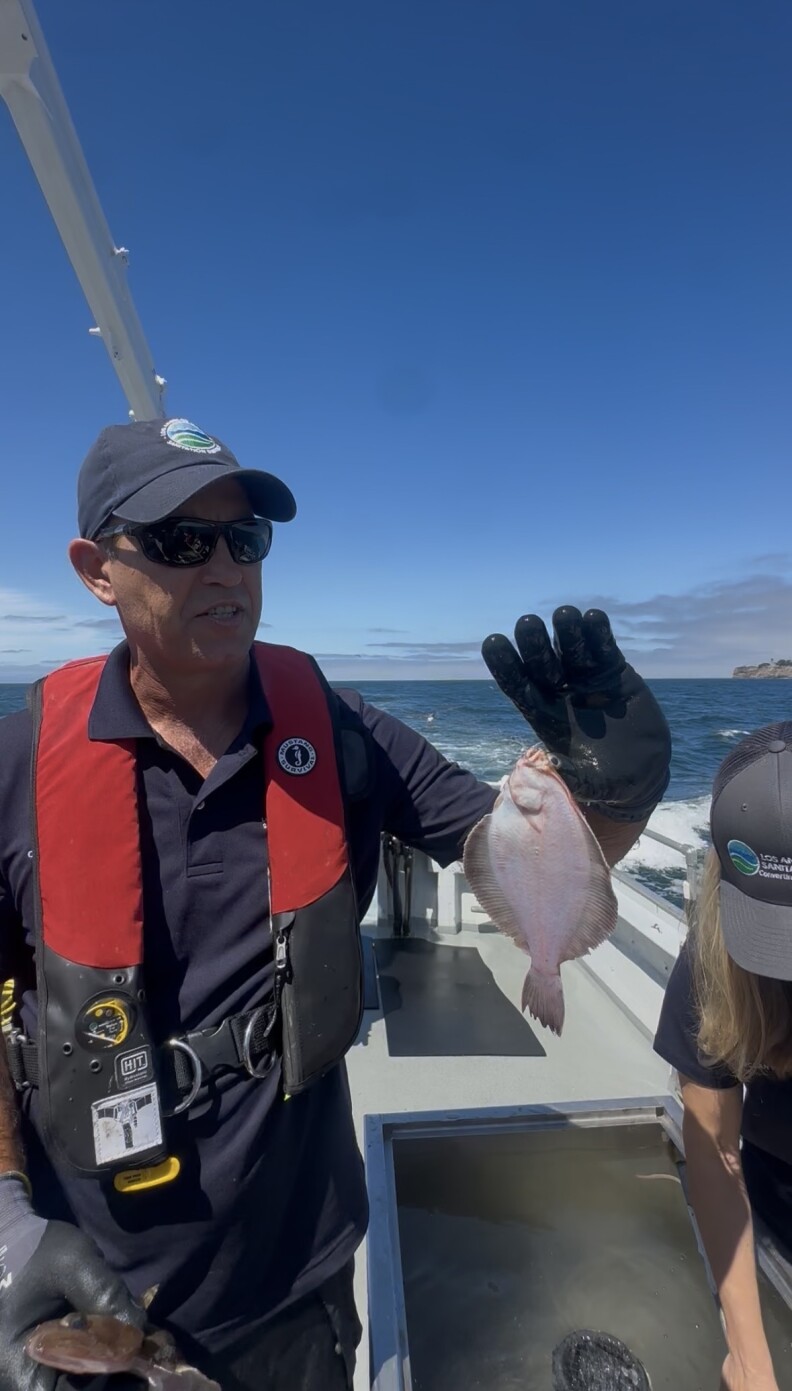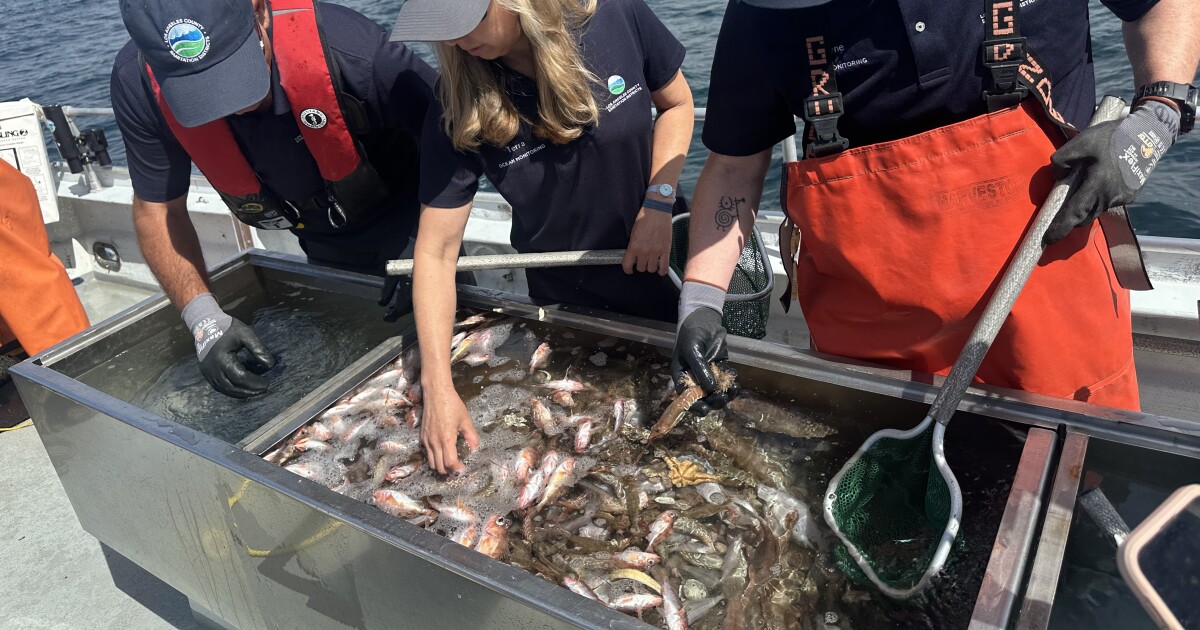Keep up with LAist.
If you’re enjoying this article, you’ll love our daily newsletter, The LA Report. Each weekday, catch up on the 5 most pressing stories to start your morning in 3 minutes or less.
Almost 400 feet beneath San Pedro, Rachel is stuck.
How ocean creatures tell us the complicated story of LA sewage treatment
Here on the surface at Averill Park, children play on the vibrant green hills. Books are open. Lunches are enjoyed.
But Rachel — an 18-foot-diameter tunneling machine — awaits the signal to resume drilling through earth that no human has touched before.
The tunnel she’s boring will eventually carry the treated wastewater of 5 million people from a plant in Carson 2 miles offshore from the Palos Verdes Peninsula in the Pacific Ocean.
This tunneling project, delayed by a recent breach, is just one part of the mostly invisible system that takes care of everything we flush or drain down a toilet, sink or shower, hoping to never see again. The Los Angeles County Sanitation Districts operate 11 wastewater treatment plants that clean the water so that, when we do see it again, it’s irrigating a green space like Averill Park. Or it’s been a benign addition to the ocean and its inhabitants (more on that later).

On the surface at Averill Park — hilly, green and tranquil — you’d never know about a massive tunneling project under San Pedro.
How it works
Treating wastewater so it can be recycled for irrigation or sent underground or into the ocean happens in three stages.
First, sewage travels through a series of pipes to arrive at a large tank, where it “settles.”
“The famous comment — there’s floaters and sinkers in all wastewater, right?” said Michael Chee, public information officer at the L.A. County Sanitation Districts.
At the settling stage, gravity separates raw, solid materials from the liquid.
These tanks are topped with an industrial grade filtration system, which scrubs the air of potent bacteria, pathogens and “ the stuff we don’t want getting out into the environment,” Chee said.
After the settling stage, bacteria are introduced to feast on the remaining organic waste.
Stage Two “is like an all-you-can-eat buffet for these bacteria,” Chee said.
At this part of the process, the brown, murky water — Chee said they call it “chocolate milk” — is now in uncovered tanks. The bacteria need oxygen and sunlight to survive.
Open tanks at the Whittier Narrows wastewater reclamation plant, where “stage two” of the wastewater treatment process is underway. The yellow buildings at left are where the primary stage of treatment takes place in sealed tanks.
More treated sewage, please! At the second stage of treatment, it’s called “chocolate milk.”
Post bacterial buffet, a final filtration system removes any solids that remain. Then, chlorine and other chemicals kill off the bacteria from the earlier stages, before the chlorine is eventually removed as well.
This water is then cleansed of contaminants, though it does not contain the right minerals and nutrients to be considered drinking quality. So each treatment plant releases the water, now called effluent, either back into the ground or for irrigation.
At the San Jose Creek plant in Whittier, which serves about 1 million people (100 million gallons of wastewater per day), the treated effluent flows back into the San Gabriel River or into the surrounding grounds for irrigation.
The A.K. Warren plant in Carson serves 5 million people, and sends the effluent 2 miles into the ocean off the Palos Verdes Peninsula.
Under the earth
But there’s a problem. The pipes that carry the treated water from Carson to the Pacific are too small and too old.
The effluent can follow two routes to the ocean, either through an 8-foot pipe built in 1937, or a 12-foot pipe from 1958.
If these tunnels (or any part of the plant) backs up, raw sewage can flow into Machado Lake or Dominguez Channel, which would end up in the L.A. Harbor. This happened during a rainstorm in 2024.
Additionally, these tunnels have never been inspected.
“ We’ve never seen inside them because treated wastewater has always been flowing through them since the minute they were operationalized,” Chee said.
So the county is in the middle of a project called Clearwater, which is designed to handle stormwater, meet modern earthquake standards and free up the older tunnels to be inspected.
Construction on the new 7-mile tunnel began in 2019.
As of July, the 780-foot-long boring machine named Rachel had already dug 6 miles of tunnel. The machine simultaneously digs through the earth and seals together panels that create the tunnel.
Did you know?
-
Tunnel boring machines are typically named after women
-
In the 16th century, miners would ask Saint Barbara, the patron saint of miners, for protection during underground construction. Today, tunneling machines are named after women to honor impactful women across disciplines.
-
For example, machines that recently dug tunnels for L.A. Metro were named after Harriet Tubman, as a tribute to the underground railroad, and Ruth Bader Ginsberg, who “paved the way” for women everywhere.
-
The Clearwater project’s Rachel was named after Rachel Carson, who was an American biologist and writer whose work helped launch the modern environmental movement. She wrote about the coast, conservation issues and raised concerns about pesticides. Her 1962 book, Silent Spring, sparked the movement to eventually ban DDT.
Because the construction takes place 30 to 400 feet underground, the construction site promised “no noticeable vibration or noise on the surface.”
Rancho Palos Verdes City Councilmember George Lewis, who serves as an alternate member on the sanitation districts’ board, said he had not heard of disturbances.
“It was sufficiently underground that it didn’t affect anybody living there,” Lewis said.
But on July 9, Rachel was halted. A breach in a stretch of the tunnel that had previously cracked collapsed, letting in over 12 feet of debris and groundwater. The partial collapse temporarily trapped 31 workers 5 miles from the only entrance point.
Nobody has entered the tunnel since the partial collapse, which has “indefinitely delayed” construction, Chee said. The cause of the breach is unclear and will not be known until people are able to enter the tunnel.
Get involved
-
- What: Town hall on Clearwater project
- Where: Dalmatian American Club, 1639 S. Palos Verdes St., San Pedro
- When: 10 a.m. to noon, Saturday, Aug. 9
- More info: Staffers from the L.A. County Sanitation Districts, as well as Supervisor Janice Hahn and L.A. Councilmember Tim McOsker, will share information and answer questions about the tunneling project.
“We’ve probably been pushed back at least a year, and we don’t have an estimate yet,” Chee said.
The tunnel was planned to be completed by 2027.
Into the sea
The construction of the Clearwater tunnel halted a mile short of Royal Palms Beach, where the 1937 and 1958 pipes connect to existing outfall pipes that extend into the ocean and discharge effluent 2 miles off the coast. These outfall pipes travel underground for a bit, and then lie on the ocean floor.
Once or twice a year, marine biologists from the L.A. County Sanitation Districts go to the outfall area and collect fish, invertebrates and other critters to compare their health with fish in areas unaffected by effluent.
The most recent trip to the outfall area, in July, gave the fish and the water a clean bill of health.
“ It’s looking as good as you would expect it to in a completely unimpacted area,” said Josh Westfall, senior environmental scientist at the county sanitation agency.
Experts look at the fish as a metric of water quality — and also to ensure that fish aren’t contaminated.
“ We also want to make sure that the fish that you and I might catch if we just go out for a weekend, that those are safe to eat,” Westfall said.
What’s out there?
Marine biologists on the recent outing showed off a diverse array of species from their trawl, which members of the media were invited to watch.
Sea slug: The first was a highly predatory sea slug (scientific name pleurobranchaea californica) which uses its radula mouth to scrape and ingest other creatures.
Marine biologist Wayne Dosset points out the gill that the sea slug uses for respiration.
The small opening is the voracious sea slug’s mouth, which it uses to catch and ingest its prey.
“They’re good predators of anything that they can catch in their mouth,” said Wayne Dossett, a biologist at the sanitation district. “They’ll just roam around looking for anything that they can ingest.”
Octopus: A young octopus joined the invertebrates tank. It was, according to Wayne, only a few months old. It released its ink when it entered the tank, an indication of stress and how they typically distract predators.
A baby octopus rests on Dossett’s hand.
The baby octopus releases ink in the tank.
“They can also change their structure to mimic a rock,” Dossett said.
Flat fish: Brent Haggan, biologist at the sanitation districts, held a flat fish, which as larvae are not flat. But as adults, their skeletons deform, and their eyes migrate to one side of their bodies.

A flat fish flies out of Haggan’s hands.
“ You got to watch for the predators, and you pray that they’re above you,” Haggan said as the fish flew out of his hands.
Sole and turbot: Haggan also showed off a big mouth sole and a horny head turbot, which he held by its horn.

Haggan holds a fish by the horn on the back of its head.
Sea pickle: Also coming aboard was a sea pickle. It is a colony of zooids (an asexual individual of a colony) that can grow to be over 100 feet, according to Dossett. It is a gelatinous being that is rigid only out of water.

Dossett shows off the sea pickle, a colony of zooids that can grow to be over 100 feet.
“ In the water, they expand because they’re full of water,” Dossett said.
An armed box crab (platymera gaudichaudii), rare in the area, also joined the voyage.
A shrimp with a purple eyespot — a defensive mechanism to fake out predators.
Progress on pollution and the future of wastewater
A trawl that brought a large volume of fish, and big fish, is a sign of improvement — of recovering and preserving the quality of the coast.
Around the 1970s, a little before the federal Clean Water Act, when the L.A. County Sanitation Districts first started doing ocean monitoring, the sewage released into the Pacific had only gone through the primary stage of treatment (remember the sinkers and floaters?).
As a result, the fish around the outfalls were either pollutant tolerant or exhibited fish rot — they had lesions or tumors.
“That was an indication that there was a high level of pollutants that they were living on,” said Terra Petry, the supervising scientist of the marine biology group.
Now, though, many of the fish are pollutant intolerant, and the fins of the flat fish look healthy.
Eventually, the fish may not be swimming in treated wastewater at all. We may be drinking a purified version of it.
A Pure Water plant is being built next to the A.K. Warren plant in Carson — this would direct treated water to 1.5 million homes, instead of the ocean, for human consumption.
